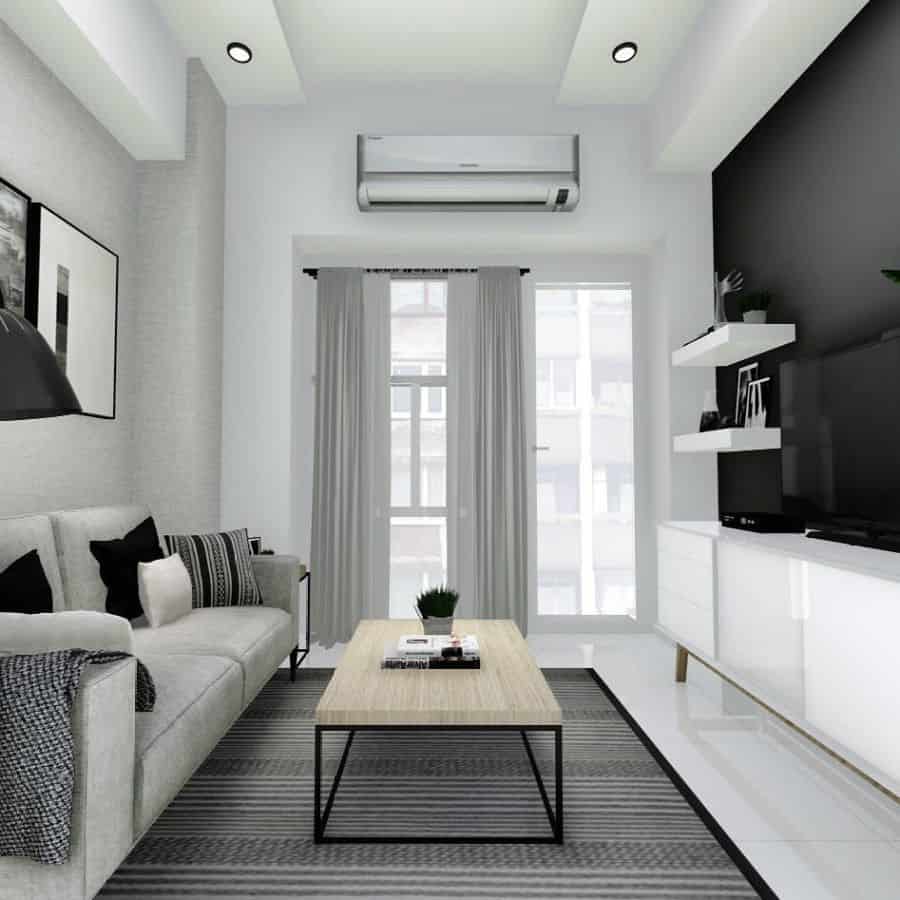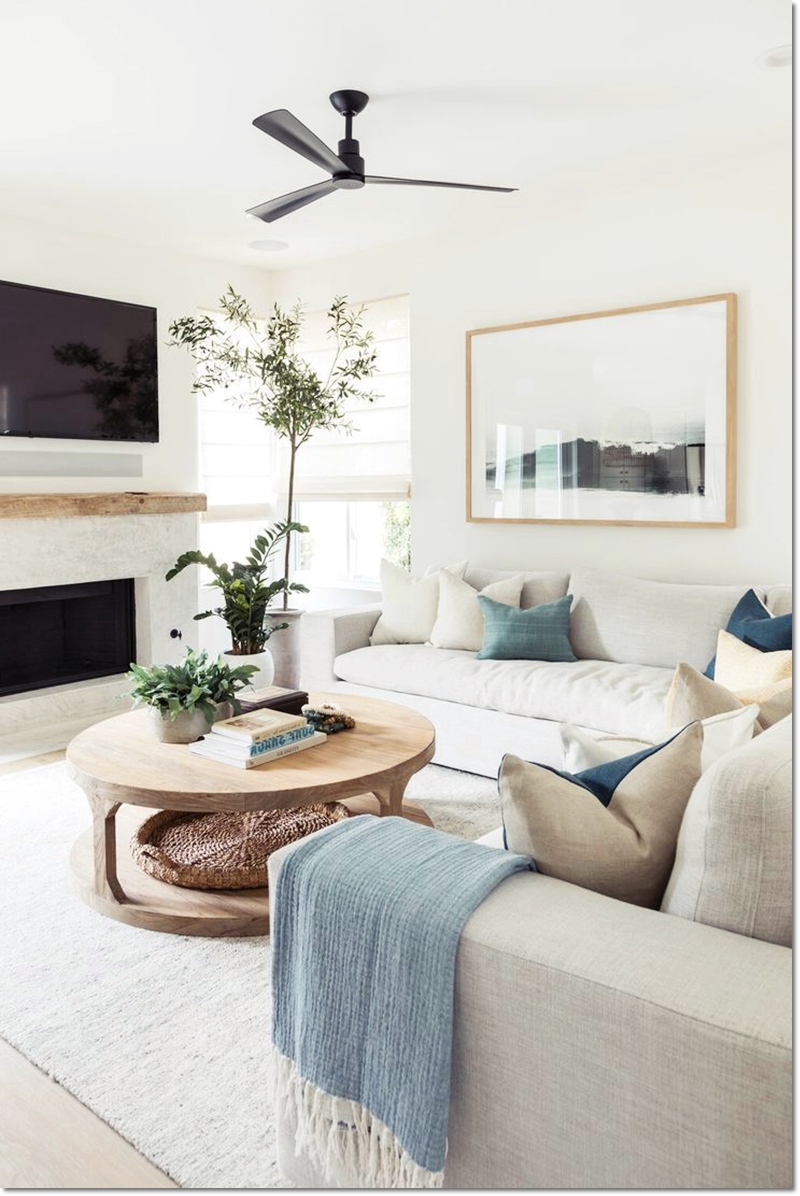Creating a minimalist small living room can be a rewarding endeavor, allowing you to maximize the space you have while maintaining a clean and uncluttered aesthetic. Minimalism is all about simplicity, functionality, and a focus on what truly matters. In this article, we’ll explore five essential tips for achieving a minimalist small living room design that is both stylish and practical. Whether you’re starting from scratch or looking to refresh your current space, these tips will help you create a serene and inviting atmosphere.

Photo by: www.pinterest.com
Tip 1: Embrace a Neutral Color Palette
One of the foundational elements of minimalist design is the use of a neutral color palette. By using soft, muted colors such as whites, beiges, grays, and light pastels, you can create an airy and open feel in your small living room. These colors reflect light and can make the space feel larger than it is.
How to Implement:
- Wall Colors: Choose light colors for your walls to provide a clean backdrop. Consider using matte finishes to avoid reflections that can disrupt the calm vibe.
- Furniture Choices: Select furniture in similar neutral tones. A light gray sofa or a white coffee table can blend seamlessly into the background, allowing for a more spacious feel.
- Textiles: Incorporate various textures in neutral shades—think soft throws, linen cushions, or wool rugs—to add depth without overwhelming the space.

Photo by: yourivyleagueimages.blogspot.com
Tip 2: Opt for Multi-Functional Furniture
In a small living room, every piece of furniture should serve a purpose. Multi-functional furniture helps you maximize your space while maintaining a minimalist aesthetic. By choosing pieces that can serve more than one function, you can reduce clutter and make the most out of your living area.
Suggested Pieces:
- Sofa Beds: Perfect for accommodating guests without needing a spare bedroom.
- Storage Ottomans: These can serve as coffee tables, additional seating, and hidden storage for blankets or magazines.
- Wall-Mounted Desks: If you need a workspace, consider a wall-mounted desk that can fold away when not in use, keeping your living room open and airy.

Photo by: dozorisozo.github.io
Tip 3: Keep Accessories to a Minimum
Minimalism is all about eliminating excess, and this is especially true when it comes to accessories. While it can be tempting to fill your living room with decorative items, keeping accessories to a minimum will help create a serene and uncluttered environment.
Strategies for Accessorizing:
- Choose Quality Over Quantity: Select a few high-quality decorative pieces that you love, rather than a multitude of smaller items. For example, a single statement vase or a piece of artwork can serve as a focal point.
- Limit Wall Decor: Instead of overcrowding your walls with artwork, consider featuring one large piece or a small gallery wall that tells a cohesive story.
- Natural Elements: Incorporate plants or natural materials sparingly. A single potted plant can bring life to the space without overwhelming it.

Photo by: bryont.net
Tip 4: Use Smart Storage Solutions
Effective storage solutions are crucial in a minimalist small living room. Keeping your belongings organized and out of sight helps maintain the clean lines and open space that define minimalist design.
Tips for Smart Storage:
- Built-In Shelving: Utilize vertical space by installing floor-to-ceiling shelves. These can be used to store books and display a few decorative items without taking up floor space.
- Hidden Storage: Look for furniture that offers hidden storage options, such as coffee tables with compartments or benches with storage inside.
- Declutter Regularly: Make it a habit to evaluate your belongings and remove items that you no longer need or use. This will help keep your space organized and true to the minimalist aesthetic.

Photo by: www.pinterest.com
Tip 5: Prioritize Natural Light
Natural light is a key component of minimalist design, contributing to an open and airy atmosphere. Maximizing natural light in your small living room can help create a sense of space and tranquility.
Ways to Enhance Natural Light:
- Window Treatments: Choose sheer curtains or blinds that can easily be drawn open to allow as much light in as possible. Avoid heavy drapes that can darken the space.
- Reflective Surfaces: Incorporate reflective surfaces, such as mirrors or glossy finishes, to bounce light around the room. A large mirror can also create an illusion of depth, making the space appear larger.
- Strategic Furniture Layout: Arrange furniture to avoid blocking windows. Position larger pieces away from light sources to ensure that sunlight can flow freely throughout the room.
:max_bytes(150000):strip_icc()/sunday-open-house-minimal-bohemian-interior-style-with-regard-to-bohemian-minimalist-bedroom-5b896e3446e0fb00504cc3d9.jpg)
Photo by: www.thespruce.com
FAQ
Q: How can I make my small living room feel more spacious?
A: To make your small living room feel more spacious, use a light and neutral color palette, opt for multi-functional furniture, maximize natural light, and keep accessories to a minimum.
Q: What are some examples of multi-functional furniture?
A: Examples include sofa beds, storage ottomans, wall-mounted desks, and coffee tables with storage compartments. These pieces help you save space while providing additional functionality.
Q: How can I incorporate color into a minimalist design?
A: While a minimalist design often focuses on neutrals, you can still incorporate color through a few carefully selected accessories, such as a unique piece of artwork, a brightly colored throw pillow, or a single statement plant.
Q: What types of storage solutions work best for small living rooms?
A: Built-in shelving, under-sofa storage boxes, furniture with hidden compartments, and wall-mounted storage units are excellent solutions for maximizing storage in small spaces.
Q: How often should I declutter my living room?
A: It’s a good practice to declutter your living room at least once every season. Regularly evaluating your belongings helps maintain a minimalist aesthetic and prevents clutter from building up.
Conclusion
Creating a minimalist small living room is all about embracing simplicity and functionality. By following these five design tips—using a neutral color palette, opting for multi-functional furniture, minimizing accessories, implementing smart storage solutions, and maximizing natural light—you can transform your living space into a serene and stylish haven. Remember, the goal of minimalism is to create a space that reflects your personality while remaining functional and uncluttered. With a little thought and creativity, you can achieve a beautiful minimalist small living room that you’ll love spending time in.
